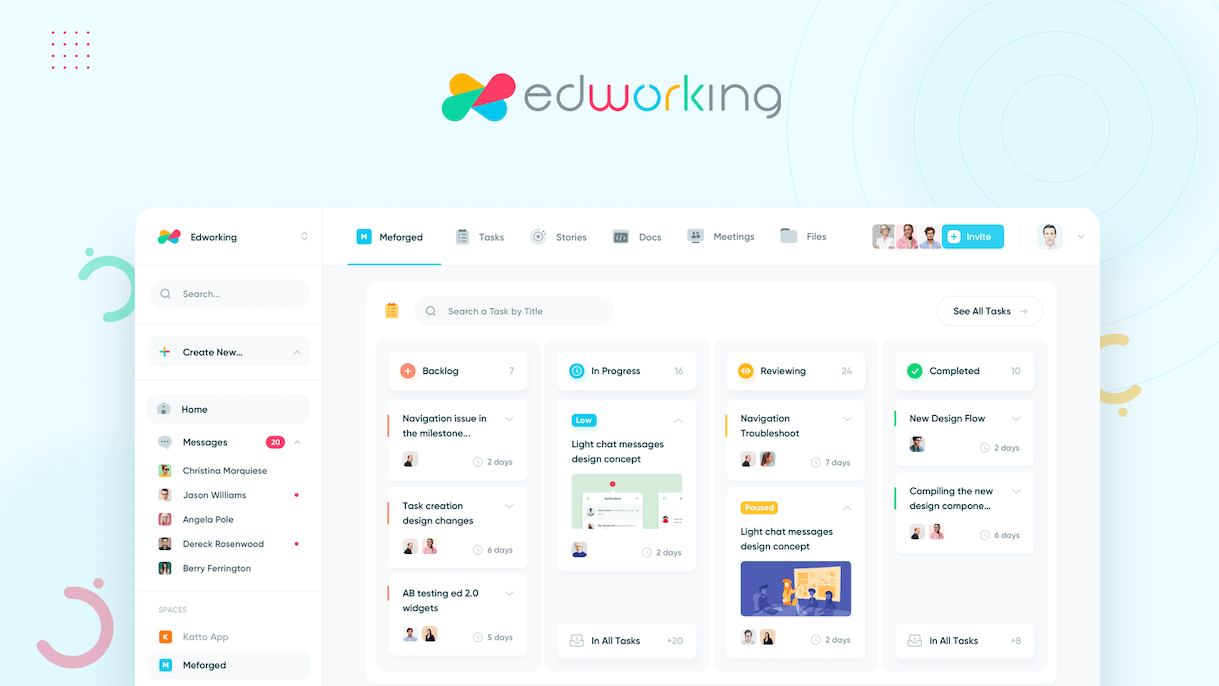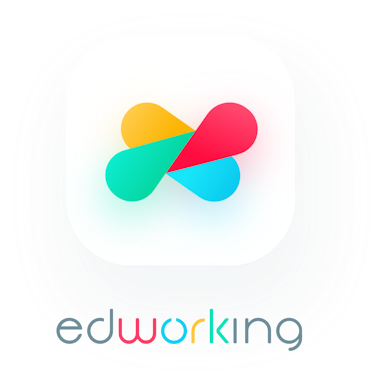Cross-functional teams are no longer a buzzword — they’re the beating heart of innovation in today’s fast-moving business world. Think about the last time you launched a product or tackled a complex problem. Chances are, success didn’t come from one department alone. Instead, it required marketing, engineering, operations, and even customer service working together. That’s the power of a well-run cross-functional team.
But managing these teams efficiently? That’s a whole different story.
Cross-functional teams come with incredible potential: diverse expertise, creativity, and speed. Yet they also come with headaches — clashing priorities, communication gaps, and unclear leadership. Sound familiar?

In this article, we’ll walk through the essentials of how to manage cross-functional teams effectively. You’ll learn why these teams are essential, the challenges they face, and proven strategies to make them work. We’ll even show how tools like Edworking can streamline your collaboration like never before.
Ready to take your team from “functional” to “unstoppable”? Let’s dive in.
 Understanding Cross-Functional Teams
Understanding Cross-Functional Teams
What are cross-functional teams?
A cross-functional team is like a dream team pulled from across your company. Picture this: a designer from marketing, a developer from IT, a salesperson, and a product manager — all working together toward a shared goal. These teams cut across departmental lines and bring a variety of skills to the table.
They’re assembled not by department, but by objective. And that’s what makes them so powerful.
Whether it’s launching a new app, entering a new market, or improving customer experience, cross-functional teams combine knowledge and perspectives that traditional teams just can’t match.
Why companies rely on them more than ever
In a world obsessed with agility and innovation, silos are the enemy. Companies need fast, creative, and collaborative problem-solving — and that’s exactly what cross-functional teams offer.
With remote work rising and product cycles getting shorter, the need for seamless collaboration across departments is at an all-time high. Tech companies, startups, and even large enterprises are leaning into this model to boost efficiency and spark innovation.
Cross-functional teams also help companies respond faster to market changes, customer needs, and unexpected challenges — something every business needs in today’s fast-paced environment.
The difference between traditional and cross-functional teams
The main difference between traditional teams and cross-functional teams lies in structure and goal alignment.
Traditional teams are built around function — think sales, finance, or HR — with clear hierarchies and well-defined roles. Cross-functional teams, on the other hand, are built around projects. They’re fluid, often temporary, and focused on a shared outcome rather than departmental objectives.
Let’s break it down:
- Traditional teams: Report to a single manager, focus on department goals.
- Cross-functional teams: Members report to different managers, align around a common project or initiative.
This creates a dynamic, if sometimes messy, collaboration environment. When managed well, though, it’s a powerhouse of productivity and innovation.
 Common Challenges in Managing Cross-Functional Teams
Common Challenges in Managing Cross-Functional Teams

Communication barriers and conflicting priorities
Let’s face it — getting people from different departments to speak the same language is tough. What’s urgent for the marketing team might be low priority for the dev team. Sales might be chasing quarterly goals while product is thinking long-term strategy.
This misalignment leads to confusion, delays, and sometimes frustration. Without clear communication and shared objectives, cross-functional teams can easily drift apart.
Another hurdle? Jargon. Every department has its own way of speaking, which can cause misunderstandings or make collaboration clunky. Ever heard a designer and a developer argue over the meaning of "responsive"?
Lack of clear leadership or accountability
Who’s in charge here?
It’s a question that haunts many cross-functional projects. When team members come from different departments, they may each have their own manager — but none of those managers may be directly overseeing the project.
Without a clear project lead or facilitator, tasks can fall through the cracks. Responsibility becomes murky, and finger-pointing can rear its ugly head when things go wrong.
Accountability is the glue that holds cross-functional teams together. Without it, even the most talented groups can spin their wheels.
Differing working styles and tools
You’ve got marketing on Trello, engineering on Jira, and HR still emailing Excel sheets. It’s chaos.
Cross-functional teams often struggle because each department brings its own preferred tools and processes to the table. Some love daily standups, others prefer weekly reports. Some need detailed documentation, others just want a Slack message.
These mismatched workflows lead to inefficiency, duplicated work, or — worst of all — dropped tasks.
Standardizing tools and creating a shared way of working is critical. Otherwise, you’re just coordinating chaos.
 Proven Strategies for Managing Cross-Functional Teams Efficiently
Proven Strategies for Managing Cross-Functional Teams Efficiently

Define clear goals and shared outcomes
When team members come from different departments, they often carry their own version of “what success looks like.” That’s why the first step is creating a unified vision.
Lay out the big picture, then break it into smaller milestones. Everyone should know what the end goal is, why it matters, and how their contribution fits into the puzzle. This builds alignment and keeps the whole team rowing in the same direction.
Clear goals also make it easier to measure progress — and celebrate wins.
Assign roles and clarify accountability
Avoid the classic “I thought someone else was handling it” trap. Assign specific roles and responsibilities from day one.
It doesn’t mean adding bureaucracy — it means creating clarity. Designate a project owner, define who’s responsible for what, and establish decision-making protocols.
Use RACI charts (Responsible, Accountable, Consulted, Informed) to make sure everyone knows where they stand. This cuts down on duplication and finger-pointing.
Foster psychological safety and open communication
People do their best work when they feel safe to speak up — even when they disagree. Psychological safety is the foundation for trust, creativity, and collaboration.
So how do you build that?
Here are some tips for fostering a communication-friendly culture:
- Hold regular sync meetings with a clear agenda
- Use one centralized platform for conversations (no more chasing Slack + email + text)
- Rotate meeting facilitators to give everyone a voice
- Recognize and reward cross-department contributions
- Encourage candid feedback and normalize respectful disagreement
When people feel heard, they show up more engaged — and that drives results.
Utilize project management tools
A central workspace is essential for visibility and accountability. Tools like Edworking, Asana, or ClickUp allow you to assign tasks, track progress, share files, and communicate — all in one place.
This eliminates the back-and-forth and keeps everyone on the same page, literally.
Look for platforms that support:
- Real-time task updates
- Cross-functional visibility
- Integrated chat and video features
- AI-powered summaries and status tracking
When tools work with your team instead of against it, collaboration becomes seamless.
 Best Practices from Successful Cross-Functional Teams
Best Practices from Successful Cross-Functional Teams
Case study-style storytelling
Let’s imagine a mid-sized tech company rolling out a new customer onboarding platform. The product team wanted a sleek UI. Marketing pushed for customer-centric messaging. Sales demanded faster deployment.
At first, chaos.
But when they implemented weekly cross-team check-ins, clearly assigned task owners, and a shared project board — magic happened. Deadlines were hit. Bugs were flagged and fixed quickly. And customers raved about the new experience.
This isn’t an isolated story. It’s a common pattern among high-performing cross-functional teams: clarity, communication, and collaboration.
Agile and scrum techniques across departments
Scrum isn’t just for developers anymore. Marketing, HR, even finance teams are adopting agile frameworks to stay aligned and responsive.
Cross-functional teams benefit hugely from lightweight agile structures:
- Sprint planning helps break large projects into digestible tasks
- Standups keep everyone aligned without bogging down schedules
- Retrospectives create space for honest reflection and improvement
You don’t need to go full-on scrum master. Just borrow what works and adapt it to your team's rhythm.
Encourage learning and role overlap
The more your team understands each other’s roles, the smoother the collaboration.
Encourage cross-training sessions. Let a designer shadow a developer. Have marketing explain their customer journey insights to product. These small investments build empathy and reduce friction.
When people understand the “why” behind someone else’s work, they’re more patient, more creative, and way more effective.
Bonus? You create future-proof team members who can flex across projects.
 How Edworking Supports Cross-Functional Teams
How Edworking Supports Cross-Functional Teams

All-in-one platform for task, chat, docs, and video
Imagine if your entire team — from marketing to engineering — could collaborate in one space without jumping between apps. That’s exactly what Edworking delivers.
With built-in tools for task management, real-time chat, video conferencing, and document sharing, Edworking removes the fragmentation that often cripples cross-functional efforts.
No more juggling Slack, Google Docs, Zoom, and Trello. It’s all there — in one clean, intuitive platform.
Built-in AI tools for clarity and efficiency
Cross-functional teams thrive on speed and precision. That’s where Edworking’s AI features step in.
Need to summarize a meeting? The AI Assistant can do it. Want to auto-generate a document draft or update a task status? Edworking’s AI Brain has you covered.
These tools cut down on manual work, reduce errors, and help teams stay aligned — even when priorities shift fast.
Better alignment through integration and visibility
One of the biggest headaches for cross-functional teams is a lack of visibility. Who’s working on what? Where’s that file? What’s the project status?
Edworking solves this with a unified dashboard that gives everyone — from CMO to developer — a clear view of what’s happening. Task dependencies, due dates, content drafts — it’s all trackable.
This level of transparency not only improves accountability but also builds trust between departments.
 Conclusion
Conclusion
Managing cross-functional teams efficiently isn’t about getting everyone to think the same — it’s about getting them to work toward the same goal.
Yes, these teams can be messy. They can challenge your patience, push your processes, and force you to rethink everything from communication to accountability. But when managed well, they are also your greatest asset.
By setting clear goals, defining roles, choosing the right tools, and building a culture of trust and learning, you can turn your cross-functional team into a powerhouse of collaboration and innovation.
And with platforms like Edworking, the path to seamless collaboration becomes a lot smoother. You’re not just managing a team — you’re unleashing its full potential.
 FAQs
FAQs
What is a cross-functional team?
A cross-functional team is made up of individuals from different departments or areas of expertise working together on a common goal or project.
Why are cross-functional teams important?
They bring diverse perspectives, promote innovation, and help solve complex problems more efficiently by leveraging a wide range of skills and experience.
How do you lead a cross-functional team?
Effective leadership involves setting clear goals, establishing roles, facilitating communication, and creating a culture of trust and accountability.
What tools help manage cross-functional teams?
Tools like Edworking, which integrate chat, task management, video, and AI-powered features, are ideal for keeping cross-functional teams aligned and productive.
What is the main challenge in cross-functional teams?
The biggest challenge is aligning different priorities, communication styles, and workflows across departments, which can lead to confusion and delays.
How can conflicts in cross-functional teams be resolved?
Encourage open dialogue, clarify roles and responsibilities early, and use neutral facilitators or project leads to mediate and refocus the team.
Are cross-functional teams more effective than traditional teams?
They can be — especially for project-based work — because they bring more diversity and adaptability to problem-solving.
How do you measure success in cross-functional teams?
Use project-specific KPIs, track collaboration effectiveness, and measure how well the team delivers outcomes aligned with business goals.
Can small companies use cross-functional teams?
Absolutely. Even in small organizations, bringing together people from different roles can boost creativity and speed up execution.
What industries benefit most from cross-functional teams?
Tech, marketing, product development, healthcare, and any industry that relies on agility and complex project execution benefit greatly from this team structure.













